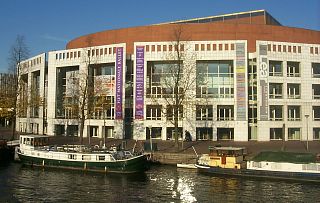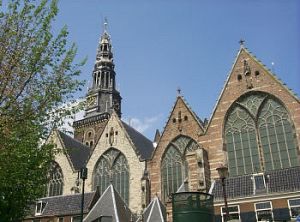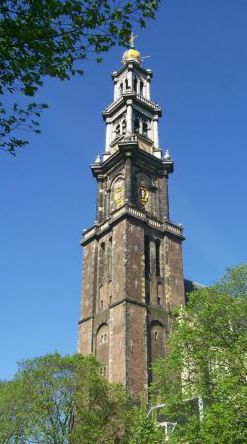
The Muziektheater (the Nationale Opera & Ballet) hosts major productions of opera, theater and ballet. Look for Shakespeare, classical operas, wonderful ballets like the Nutcracker.


The Muziektheater (the Nationale Opera & Ballet) hosts major productions of opera, theater and ballet. Look for Shakespeare, classical operas, wonderful ballets like the Nutcracker.
The Bachzaal is a medium-sized concert hall in Amsterdam-Zuid.
When I used to live on Beethovenstraat, I loved to pop down to the Bachzaal, a few blocks away, to get my fill of classical music. I’ll never forget one striking performance by a music professor playing Scriabin so intensely, I developed a great fondness for the composer.
The Bachzaal is a venue where music students hold recitals and occassionally professional musicians come to play. Most events are free, and it’s unlikely the place will be crowded, so you can enjoy fine classical music without all the commercialism.
The hall gets its name from the Bachstraat, where the room is located. Architect Piet Vorkink (1878-1960) designed the ingenious complex in 1930, of which the Bachzaal is part. The building, where musicians for the Concertgebouw Orchestra were initially trained, is an important semi-public building, of which only a few have been built in the Netherlands.
13th-century church, now Calvinist, hosting religious & cultural activities including concerts.

Originally a small wooden church on a bank of the Amstel River in the 1300’s, it grew to be the stately Gothic structure it is today during the 14th century. Over the centuries it was a place for traders to meet and a refuge for the poor.
There are two organs: a transept organ (1658) and the well-known Vater-Müller organ (1724/1738), nowadays both are used for concerts.
The floor of the interior is paved with the gravestones of the rich, famous and royals from centuries past. It is an eerie feeling indeed to be walking around on them, especially when you recognize someone you’ve heard of!
Every year they offer the World Press Photo exhibition to the public, along with other exhibitions, theater and musical concerts from time to time. Be sure to check our always updated event calendar for listings of happenings when they are announced.

This fabulous Renaissance cathedral along the beautiful Princengracht is often used for live performances. The tower is the tallest in Amsterdam at 85 meters (272 ft.). There are tours (f 5) up the tower, but they no longer go all the way to the top (thankfully!). Yet the views are outstanding!
Formerly the Stock Exchange, now a performance hall and exhibition space of note for it’s Amsterdam School architecture, since it was designed by the style’s founder, Hendrik Petrus Berlage (1856- 1934). Located right on the Damrak between Central Station and the Dam Square, you can’t miss it’s beautiful clock tower.
The Rembrandthuis Museum is where the famous painter established his own studios here in Amsterdam, and lived with his family from 1639 to 1658.
He eventually left after declaring bankruptcy, and the home has been restored with approximations of it’s original furnishings based on an inventory of his possessions from that time.
Most of the building is devoted to his daily life from the time, and is of course, filled with paintings and art.
Part two of the museum is the new museum wing, where you will find exhibition rooms. The museum shop, the entrance to the museum café, the auditorium and the Rembrandt Information Centre are also located in the new wing.
On the fifth floor is the Rembrandt Information Center, where you can research on DC-rom, in books and other publications. By appointment only.
Info:
Open daily from 10 am to 5 pm, except Sundays and holidays when they open from 1 pm to 5 pm.
Admission is 7 euros for adults, children under age 6 are free, 6 to 15 1.50 euros.
Easily reached from the Waterlooplein or the Dam Square.
If you are curious about how Dutch nobility lived in centuries past you may visit the Van Loon Museum on the Keizersgracht at number 672.
The double-sized canal house was constructed in 1672. The first person to live here was the painter Ferdinand Bol, one of Rembandt’s most famous pupils.
In the sixteenth century the Van Loon’s moved to Amsterdam from the south of Holland to flee the Spanish occupation and became respected members of Amsterdam society. Several Van Loons are former mayors (burgemeesters) of Amsterdam, and the last resident was Thora van Loon – Egidius. She was Dame du Palais of Queen Wilhelmina for forty years.
The house is filled with an amazing collection of artwork, and has exhibitions on a regular basis.
An added bonus here is the spectacular gardens behind the house, which have been extensively renovated over the centuries into an amazing creation, in formal Dutch style of course.
Info:
Open Fridays through Mondays from 11 am until 5 pm. Admission is 4.50 euros for adults. Museumjaarkart holders are admitted free, children under 12 are fee.
The Dutch Resistance Museum (Verzetsmuseum)
The museum itself provides the best description:
“The exhibition tells a chronological story from approximately 1930 to 1950, in which information is offered in various ‘layers’. A visitor striding through the exhibition will get an overall picture of a rather indolent Dutch society in the thirties, experience the shock of the unexpected German invasion, then discover that both the oppression and resistance to it gradually intensify in the occupation years as the war progresses, finally to realize that experiences of this period are still playing a role in today’s society. A visitor looking a little more closely will be able to gather more detailed information, particularly from individual examples.”
Info:
Located near the Hortus and the Artis on the east side of Amsterdam. To get there take tram #9 or 14 to Plantage Middenlaan and walk two short blocks to the door.
Fine example of Dutch life aboard one of the unique houseboats lining Amsterdam’s canals. Go on board yourself to look around, and marvel at the comfy interiors made from the former cargo holds of these former commercial boats.
Located in the heart of Amsterdam, on the Prinsengracht opposite #296.
Open Wednesday through Sunday 11 to 5 in March through October. During the winter months from November to February open only on Friday, Saturday and Sunday from 11 to 5pm. Adult admission is 4.75 guilders.
The Jordaan was build at the large expansion of Amsterdam in early 17th century, as a district for the working class and emigrants. The population increase during the next centuries was enormously, caused by the stream political refugees like protestant Fleming, Spanish and Portuguese Jews and French Huguenots who mainly settled in the Jordaan. It was a poor district with small houses and slums, every little room stuffed with families and lots of children. The entire area was one ghetto with open sewers, canals served for both transport and sewer, and no running water. Around 1900 there lived about 80 thousand people, nowadays about 20 thousand.